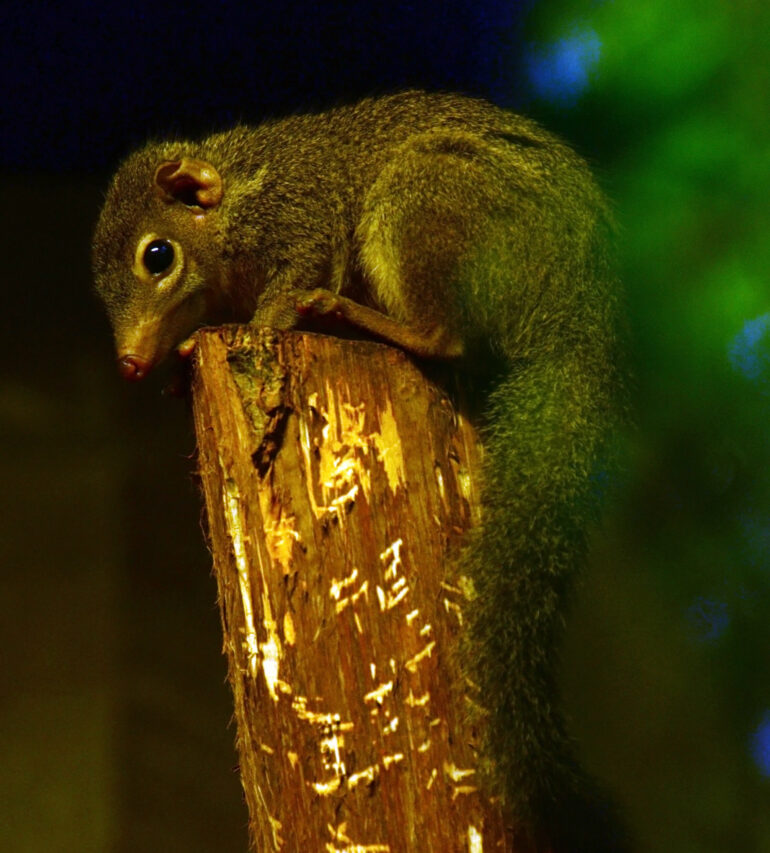The Northern Treeshrew, a small, bushy-tailed mammal native to South and Southeast Asia, defies two of the most widely tested ecological “rules” of body size variation within species, according to a new study coauthored by Yale anthropologist Eric J. Sargis.
The unexpected finding, researchers say, may be attributable to climate change—the body size rules reversed in Northern Treeshrews as average temperatures climbed—and likely exists in other species.
The first-of-its-kind study, published Nov. 29 in the journal Scientific Reports, found that the Northern Treeshrew (Tupaia belangeri) breaks both Bergmann’s rule and the island rule. The former describes a common pattern wherein individuals of a warm-blooded species inhabiting colder climates—generally located at higher latitudes—have larger average body sizes than those in warmer climates, which are usually at lower latitudes. The latter predicts that small mammal species evolve larger body sizes on islands than their mainland counterparts, whereas island-bound large mammals evolve smaller body sizes.
Although both rules have been repeatedly tested from a strictly geographic standpoint, how they interact—and possibly even change over shorter timescales amidst rapid climate change—has never been rigorously examined.
In the first published study to do so, Sargis and his coauthors analyzed 839 museum specimens of adult Northern Treeshrews collected over 130 years from across their entire geographic range, including mainland and island populations, along with historical climate data.
They found that, contrary to Bergmann’s rule, body size of the Northern Treeshrew increased in warmer climates closer to the equator. More importantly—and quite unexpectedly—they discovered that both rules have reversed over a remarkably brief period between the late 19th and 20th centuries, with the reversal accelerating as average temperatures rose.
“Our study highlights that body size is linked to dynamic and potentially interdependent ecological factors,” said lead author Maya Juman, a Ph.D. student at the University of Cambridge. “It is critical to test these patterns in conjunction with one another, and across both space and time. We need to revisit ecogeographical rules in the context of climate change, which may be rewriting them.”
“This is the first time a rule reversal like this has been found in any species,” said Sargis, professor of anthropology in Yale’s Faculty of Arts and Sciences, the director of the Yale Institute for Biospheric Studies (YIBS), and the study’s senior author. “The finding shows that body size variation and responses to changing temperature are much more complex than predicted.”
The study also found that the two rules are intertwined. While mainland Northern Treeshrews clearly break Bergmann’s rule, island-bound individuals adhered to it, tending to be larger at higher latitudes and smaller at lower latitudes. This means that the island rule is upheld at higher latitudes but reversed in warmer latitudes closer to the equator, the researchers noted.
The researchers suggest that Northern Treeshrews likely aren’t the only species that break the body size rules.
“Many traditional tests of Bergmann’s rule in living species have ignored time, since up until very recently it was assumed body size can’t significantly change over the course of decades, and that’s the timescale we’re stuck with when it comes to specimen-based research,” said study coauthor Link E. Olson, curator of mammals and professor of biology at the University of Alaska Museum and both a curatorial affiliate in mammalogy at the Yale Peabody Museum and a former YIBS Bass Distinguished Visiting Environmental Scholar. “I think we’re in for many more similar surprises.”
The researchers’ dataset, drawn from 16 museums including the Yale Peabody Museum, demonstrates the importance of museum collections in enabling scientific research, said Sargis, curator of mammalogy and vertebrate paleontology at the Peabody.
“This work would be impossible without the museum specimens,” he said. “Not only did the specimens yield important anatomical and body size data, but the associated information concerning the date and location where they were collected allowed us to examine the two rules over a long period of time, across the species’ entire geographic distribution, and in relation to historical climate data from the region.”
Olson and study coauthor Virginie Millien, associate professor of biology and curator of zoology and paleontology at the Redpath Museum at McGill University, were among the first scientists to investigate the effects of recent climate change on animal body size. A study they published in 2006 concluded that one could use the past to predict future body-size change within species in a rapidly warming climate.
“I have spent decades studying the evolution of size in fossil mammals, from the mainland and islands, over thousands or millions of years,” Millien said. “While the findings in this latest study seem surprising, it really isn’t so startling to observe body size changes at a much smaller time scale given the warming planet.”
More information:
Maya M. Juman et al, Recent and rapid ecogeographical rule reversals in Northern Treeshrews, Scientific Reports (2022). DOI: 10.1038/s41598-022-23774-w
Citation:
An ecological rule breaker shows the effects of climate change on body size evolution (2022, November 29)



